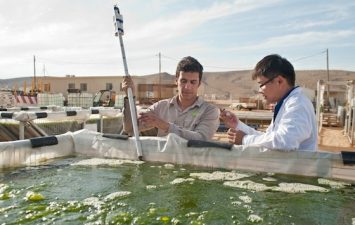Algae as superfood? Countries like Japan have already known for years about the possibilities of using algae as a nutritious food product, as any sushi fancier will attest to. Growing algae to feed the world’s hungry may soon become a viable reality as some forms of algae like spirulina, actually a form of cyanobacteria and up to now much more expensive to produce as a food source.
This cost factor may now be reduced significantly due to a project being conducted by high school students at Israel’s Gymnasia Herzliya in Tel Aviv. The school program actually began back in 2013 when the high school students began experimenting with growing the algae in plastic bottles in what they referred to as the Algeed Superfood Project.
Spirulina has been found to contain as much as 70% protein and as such can be a tremendous help to feeding countries such as those in Africa whose large populations suffer from high levels of malnutrition. Since its original inception, the Tel Aviv high school project has expanded to actual involvement with African countries like Rwanda and the Democratic Republic of the Congo.
“The idea is to find a low cost nutrition solution to feed the world’s hungry,” says Ben Berger, the project head. Congolese Agricultural representatives recently visited the high school, whose students took on the project six years ago to find a way to reduce significantly the cost of producing the highly nutritious algae at a lower cost than had been done up to now when spirulina was mostly sold in health foods stores at a much higher cost. Spirulina in its natural state, usually looks like the photo below:

Dr. Zeev Degani, the school principal, is very happy that the project is taking place at his school which has expanded it to the point where some of the students have actually visited African locations to see the progress being made to produce the algae there. The Gymnasia Herzliya students have developed a way to grow the algae in plastic drink bottles, an item that is plentiful all over Africa and usually discarded in trash dumps. The program was aired recently on Israel’s Channel 13 news program.
Beginning originally on South Africa, the project is also being tried in Rwanda, Ethiopia, Kenya and the Democratic Republic of Congo, where more than 1.5 million children suffer from various forms of malnutrition. “Instead of being dependent on aid programs, which usually end after a period of time, why not focus on something that will enable countries to provide their own nutrition solutions?” said a representative of the Lwiro Research Center of Natural Sciences in the Dem. Republic of the Congo.
More about algae as a food and fuel source:
Adding spirulina to felafel could yield the next superfood
Algae returns as fuel for our future
Israeli Teens Bottle Algae in “Algeed” Superfood Project for a Hungry Africa




